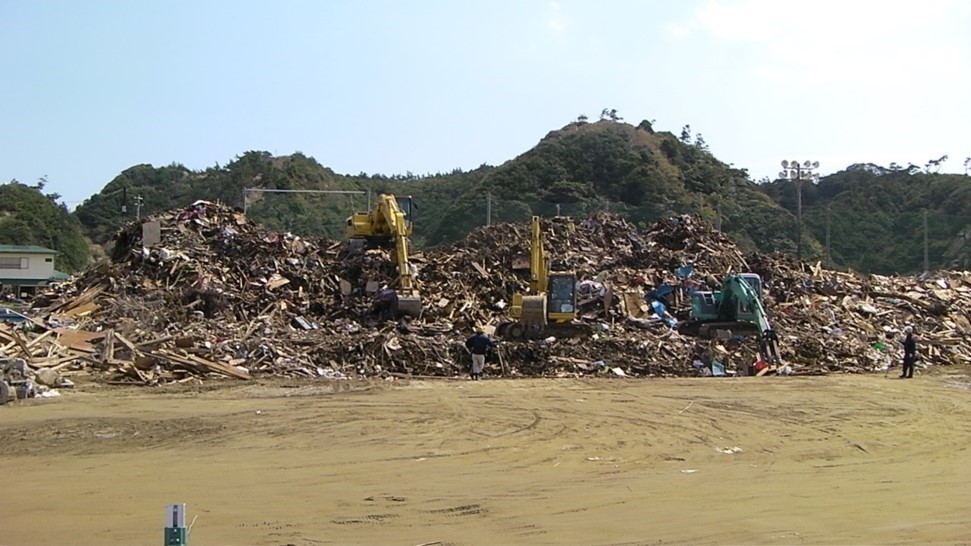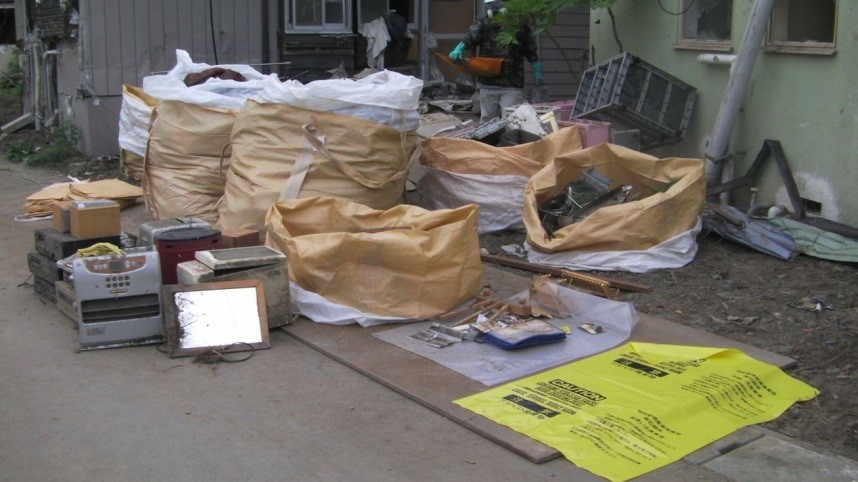- Waste management in Japan
- Circular economy in Japan
- Waste management in Asia
- Disaster waste management
Disaster Waste Carried into Temporary Storage Sites
Amount of disaster waste and temporary storage sites
The 2011 Great East Japan Earthquake and Tsunami caused tremendous damage to northeastern Japan, especially its coastal regions. It generated approximately 22.49 million tons (in Japanese, external link) of disaster waste such as rubble and debris in Iwate, Miyagi and Fukushima prefectures altogether. In addition, the tsunami washed up tens of millions of tons of sediments ("tsunami deposits") from the ocean floor.
In the above-mentioned three prefectures, 316 temporary storage sites (TSSs) were installed with a total area of 957 hectares (as of December 27, 2011 [in Japanese, external link],) which was about 9.5 times the combined area (about 100 hectares) of Tokyo Disneyland and Tokyo Disney Sea. However, the 957-hectare area was still insufficient because not every part of the TSSs can store rubble and debris. The TSSs also needed spaces for trucks to pass through as well as spaces for crushing and sieving the waste. Since the land area secured for TSSs was different from region to region, some sites had a large pile of rubble/debris whose height sometimes exceeded 5 meters. Heat was accumulated in these piles, and it led to more cases of spontaneous ignition (in Japanese, external link).

Debris carried into TSSs
The 316 TSSs received a diverse range of disaster waste, most of which was rubble/debris such as the one broken and mixed by the tsunami, or the one generated from the demolition of half-destroyed buildings. While called collectively as "debris," it included various matters such as concrete, wood, plastics, mementos and bicycles. Especially for the first few months after the disaster, only wooden houses and buildings were demolished in the affected areas due to unavailability of machinery for dismantling concrete and steel buildings. As a result, the debris in the TSSs contained a large amount of wood until around the fall of 2011. Besides the wood from demolished structures, many fallen trees and branches were also brought into the TSSs, including the ones from windbreak trees and roadside trees. On the other hand, base concrete of houses/buildings was left for marking their original locations as the earthquake induced ground displacement and the tsunami blurred property boundaries. The types and amount of debris entering the TSSs was estimated using the reference data from past disasters such as the 1995 Great Hanshin-Awaji Earthquake (in Japanese), but the actual amount of concrete debris turned out to be much smaller than the estimated one. This was because neither the base concrete nor the concrete from dismantled buildings was brought into the TSSs during that period. It was wood that stood out in the TSSs.
In the tsunami-affected areas, demolition works were conducted without sorting materials beforehand, unlike normal times. This was because the debris was all mixed by the tsunami and difficult to separate, and because people rushed to remove it. As a result, most rubble/debris entering the TSSs was in a mixed and unsorted state. It was piled up in the TSSs, and then sorted manually or by machine. The demolition waste and the removed debris could contain hazardous substances such as asbestos. These hazardous substances also needed to be separated in the TSSs as their pre-sorting had not been conducted. The sorting of debris in TSSs has limitations and is time-consuming and costly. To better understand this point, suppose you pick up trash in your town. It would be more efficient to pre-sort the trash and put them in separate bags than to collect them all in the same bag and sort them afterwards.
Another problem also became apparent. Ordinary sorting or crushing was not effective to turn the mixed debris into usable resources as it contained sand and soil (sediments) of the tsunami deposits (in Japanese). In the cases of freshwater floods, shaking or drying the debris can remove sediments from it. However, the same processes could not remove sticky sediments brought by the tsunami (sea water). This also made the treatment of debris much harder after the tsunami. This phenomenon is the same as our skin becoming sticky after we swim in the ocean. We foresee that various types of technologies will be mobilized for this treatment.
Pre-sorting helps even in treating disaster waste
Rapid removal of debris was necessary for quick recovery and reconstruction, and in consideration of the sentiment of the people who were affected by the disaster. However, in retrospect, questions remain whether it was the right choice especially if we consider the time and money spent for the removal and the difficulties of treating the debris afterwards. There may have been any other method for sorting various materials before demolishing and removing debris during the disaster, even if it is not the same as the method for normal times.

Kamaishi City in Iwate Prefecture, in its pilot project, examined the effectiveness of sorting various materials prior to the debris demolition and removal. The results suggested that the prior sorting could provide various advantages: enabling the segregation of hazardous substances such as asbestos, increasing the recycling rate, facilitating the management of mementos, and simplifying the handling of debris in the TSSs. The results also suggested that the following processes would not prolong the total processing time: manual segregation of hazardous substances during demolition → manual separation and storing of mementos → demolition of the remaining debris by machine → coarse sorting and transportation of debris to TSSs. The National Institute for Environmental Studies believes that it is important to verify the above-mentioned advantages using scientific data and information, and to explore proper treatment methods for disaster waste in terms of both time and money required.


